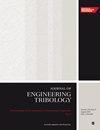Elastohydrodynamic lubrication of soft-layered rollers and tensioned webs in roll-to-plate nanoimprinting
IF 1.8
3区 工程技术
Q3 ENGINEERING, MECHANICAL
Proceedings of the Institution of Mechanical Engineers, Part J: Journal of Engineering Tribology
Pub Date : 2023-07-04
DOI:10.1177/13506501231183860
引用次数: 0
Abstract
This work presents the development of a numerical model for the elastohydrodynamic lubrication of roll-to-plate nanoimprinting with flexible stamps. Roll-to-plate nanoimprinting is a manufacturing method to replicate micro- and nanotextures on large-area substrates with ultraviolet-curable resins. The roller is equipped with a relatively soft elastomeric layer, which elastically deforms during the imprint process. The elastic deformation is described by linear elasticity theory. It is coupled to the pressure build-up in the liquid resin film, which is described by lubrication theory. The flexible stamp, which is treated as a tensioned web, is pre-tensioned around the roller. The elastic deformation of the tensioned web is described by the large-deflection bending of thin plates equations, considering its non-negligible bending stiffness. A Fischer–Burmeister complementarity condition captures the contact mechanics between the tensioned web and the roller. The governing equations combine in a coupled elastohydrodynamic lubrication model, which is fully described by a set of non-dimensional numbers. These are used in a parameter study to investigate the effect on the pressure and film height distributions. It is shown that the bending stiffness of the tensioned web results in an additional hydrodynamic pressure peak and corresponding minimum in the film height, near the inlet of the roller contact. An increase of the bending stiffness corresponds to a decrease in film height. The numerical results are compared with benchmarks from literature and experimentally validated with layer height measurements from flat layer imprints. Good agreement is found between the numerical and experimental results.软层辊和张紧腹板在辊到板纳米压印中的弹性流体动力润滑
这项工作提出了一个数值模型的发展弹性流体动力润滑的滚到印版纳米压印柔性邮票。卷到板纳米压印是一种利用紫外线固化树脂在大面积基材上复制微纳米纹理的制造方法。滚筒上装有相对柔软的弹性体层,该弹性体层在压印过程中具有弹性变形。弹性变形用线弹性理论来描述。它与液体树脂膜中的压力积聚相耦合,这是润滑理论所描述的。柔性邮票,这是作为一个张紧腹板,是预张紧围绕辊。考虑到受拉腹板的弯曲刚度不可忽略,用薄板大挠度弯曲方程描述了腹板的弹性变形。费歇尔-伯迈斯特互补条件描述了张力腹板与滚轮之间的接触力学。控制方程结合在一个耦合的弹流动力润滑模型中,该模型由一组无因次数完全描述。这些参数用于研究对压力和膜高度分布的影响。结果表明,张拉腹板的弯曲刚度导致在靠近滚子接触入口的膜高度处产生一个附加的动水压力峰值和相应的最小值。弯曲刚度的增加对应于膜高度的降低。数值结果与文献基准进行了比较,并与平面层压痕的层高测量结果进行了实验验证。数值结果与实验结果吻合较好。
本文章由计算机程序翻译,如有差异,请以英文原文为准。
求助全文
约1分钟内获得全文
求助全文
来源期刊

CiteScore
4.20
自引率
5.00%
发文量
110
审稿时长
6.1 months
期刊介绍:
The Journal of Engineering Tribology publishes high-quality, peer-reviewed papers from academia and industry worldwide on the engineering science associated with tribology and its applications.
"I am proud to say that I have been part of the tribology research community for almost 20 years. That community has always seemed to me to be highly active, progressive, and closely knit. The conferences are well attended and are characterised by a warmth and friendliness that transcends national boundaries. I see Part J as being an important part of that community, giving us an outlet to publish and promote our scholarly activities. I very much look forward to my term of office as editor of your Journal. I hope you will continue to submit papers, help out with reviewing, and most importantly to read and talk about the work you will find there." Professor Rob Dwyer-Joyce, Sheffield University, UK
This journal is a member of the Committee on Publication Ethics (COPE).
 求助内容:
求助内容: 应助结果提醒方式:
应助结果提醒方式:


